Studying Saraha: Technical and Multi-Analytical Investigation of the Painting Materials and Techniques in an 18th Century Tibetan Thangka
Abstract
1. Introduction
2. Materials and Methods
2.1. The Thangka
2.2. Methodology
- A preliminary visual examination of the painting, including observations under magnification, in order to assess its condition. Digital microscopy was used to capture details related to the underdrawing and painting technique (Stage 1).
- The use of non-invasive imaging techniques, including broadband multispectral imaging (MSI), short-wave infrared reflectography (SWIR) and X-radiography (Stage 2a). The increasing depth of penetration of each technique into the paint layers allowed the various layers of the composition to be studied. At this stage, the nature of some of the colourants and drawing media could already be identified. However, where further information was required, this was supplemented by spot measurements of areas of interest using fibre optic reflectance spectroscopy (FORS), which further elucidated the nature of the colourants employed (Stage 2b).
- A strategic sampling campaign enabled by this combined data set, in which a very low number of samples were taken for further analysis, based on similarities between coloured areas observed by MSI and FORS. The samples were investigated using Fourier transform infrared (FTIR) and Raman spectroscopy (Stage 3).
2.2.1. Visual Examination and Digital Microscopy
2.2.2. Broadband Multispectral Imaging (MSI)
2.2.3. Short Wave Infrared Reflectography (SWIR)
2.2.4. X-Radiography
2.2.5. Fibre Optic Reflectance Spectroscopy (FORS)
2.2.6. Raman Spectroscopy
2.2.7. Fourier Transform Infrared (FTIR) Spectroscopy
3. Results
3.1. Stage 1—Visual Examination and Microscopy
3.2. Stage 2a—Non-Invasive Analysis (Imaging)
3.2.1. Broadband Multispectral Imaging (MSI)
3.2.2. Short Wave Infrared Reflectography (SWIR)
3.2.3. X-Radiography
3.3. Stage 2b—Fibre Optic Reflectance Spectroscopy (FORS)
3.4. Stage 3—Invasive Analysis
4. Discussion
5. Conclusions
Supplementary Materials
Author Contributions
Funding
Data Availability Statement
Acknowledgments
Conflicts of Interest
References
- Shaftel, A. Conservation Treatment of Tibetan Thangkas. J. Am. Inst. Conserv. 1991, 30, 3–11. [Google Scholar] [CrossRef]
- Sankrityayana, R. Technique in Tibetan paintings. Asia Mag. 1937, 16, 30–33. [Google Scholar]
- Tucci, G. Tibetan Painted Scroll; Libreria dello Stato: Roma, Italy, 1949. [Google Scholar]
- Bruce-Gardner, R. Himalayan scroll paintings: Conservation parameters. Conservator 1988, 12, 3–14. [Google Scholar] [CrossRef]
- Klimburg-Salter, D.E.; Orientale, M.N.D.A. Discovering Tibet: The Tucci Expeditions and Tibetan Paintings; Skira: Milan, Italy, 2015. [Google Scholar]
- Huntington, J.C. The iconography and structure of the mountings of Tibetan paintings. Stud. Conserv. 1970, 15, 190–205. [Google Scholar]
- Huntington, J.C. The technique of Tibetan paintings. Stud. Conserv. 1970, 15, 122–123. [Google Scholar]
- Jackson, D.P.; Jackson, J.A. Tibetan Thangka Painting: Methods & Materials; Serindia Publications: London, UK, 1984. [Google Scholar]
- Jackson, D.P. A History of Tibetan Painting: The Great Tibetan Painters and Their Traditions; Austrian Academy of Sciences Press: Vienna, Austria, 1996. [Google Scholar]
- Jackson, D.P. Patron and Painter: Situ Panchen and the Revival of the Encampment Style; Rubin Museum of Art: New York, NY, USA, 2009; Volume 1. [Google Scholar]
- Jackson, D.P.; Linrothe, R.N.; Luczanits, C. The Place of Provenance: Regional Styles in Tibetan Painting; Rubin Museum of Art: New York, NY, USA, 2012. [Google Scholar]
- Shaftel, A. Notes on the Technique of Tibetan Thangkas. J. Am. Inst. Conserv. 1986, 25, 97–103. [Google Scholar] [CrossRef]
- Cotte, S. Conservation of Thangkas-A Review of the Literature Since the 1970s. Stud. Conserv. 2011, 56, 81–93. [Google Scholar] [CrossRef]
- Mehra, V.R. Note On The Technique And Conservation Of Some Thang-Ka Paintings. Stud. Conserv. 1970, 15, 206–214. [Google Scholar]
- Bruce-Gardner, R. Realizations: Reflections on Technique in Early Central Tibetan Painting. In Sacred Visions: Early Paintings from Central Tibet; Kossak, S., Singer, J.C., Eds.; Metropolitan Museum of Art: New York, NY, USA, 1998. [Google Scholar]
- Duffy, K.I.; Elgar, J.A. An investigation of palette and color notations used to create a set of Tibetan thangkas. In Proceedings of the Historical Painting Techniques, Materials, and Studio Practice: Preprints of a Symposium, Leiden, The Netherlands, 26–29 June 1995. [Google Scholar]
- Elgar, J. Tibetan thang kas: An overview. Pap. Conserv. 2006, 30, 99–114. [Google Scholar] [CrossRef]
- Leona, M.; Jain, S. Crossing the line: The interplay between scientific examination and conservation approaches in the treatment of a fifteenth century Nepali thangka. In Scientific Research on the Pictorial Arts of Asia: Proceedings of the Second Forbes Symposium at the Freer Gallery of Art; Jett, P., McCarthy, B.E., Winter, J.F., Eds.; Archetype: London, UK, 2005. [Google Scholar]
- Mass, J.; Huang, J.; Fiske, B.; Shaftel, A.; Zhang, X.; Laursen, R.; Shimoda, C.; Matsen, C.; Bisulca, C. Thangka Production in the 18th 21st Centuries: Documenting the Introduction of Non-Traditional Materials into Himalayan Painting Practice. In Proceedings of the Forum on the Conservation of Thangkas: Special Session of the ICOM-CC 15th Triennial Conference, New Delhi, India, 26 September 2008. [Google Scholar]
- Duffy, K.; Elgar, J. Examination of thangkas from Central and Eastern Tibet. In Art’99—6th International Conference on “Non Destructive Investigations and Microanalysis for the Diagnostics and Conservation of the Cultural and Environmental Heritage; ICCROM: Rome, Italy, 1999. [Google Scholar]
- Duffy, K.; Elgar, J. Five protective goddesses (Pancaraksha): A study of color notations and pigments. In Scientific Research in the Field of Asian Art: Proceedings of the First Forbes Symposium at the Freer Gallery of Art; Jett, P., Douglas, J.G., McCarthy, B.E., Winter, J.F., Eds.; Archetype: London, UK; Washington, DC, USA, 2003; pp. 164–169. [Google Scholar]
- Breeze, C.; Smith, K. Crossing The Boundaries between Conservation Disciplines in the Treatment of Asian Thangkas. In Proceedings of the American Institute for Conservation of Historic & Artistic Works: 40th Annual Meeting, Albuquerque, NM, USA, 8–11 May 2012. [Google Scholar]
- Fang, X.; Zhang, R.; Shi, N.; Song, J. Conservation of the modern thangka, Caturbhuji-Avalokiteshvara. Stud. Conserv. 2016, 61 (Suppl. S2), 289–290. [Google Scholar] [CrossRef]
- Song, J.; Fang, X. Conservation of thangkas in the Palace Museum, Beijing, China. Stud. Conserv. 2014, 59 (Suppl. S1), S134–S136. [Google Scholar] [CrossRef]
- Migdail, D. In Consideration of the Thangka. In Proceedings of the Textile Specialty Group Postprints: American Institute for Conservation of Historic & Artistic Works, 42nd Annual Meeting, San Francisco, CA, USA, 28–31 May 2014. [Google Scholar]
- Cotte, S. Reflections Around the Conservation of Sacred Thangkas. J. Conserv. Mus. Stud. 2013, 11, Art. 3. [Google Scholar] [CrossRef]
- Ernst, R.R. In situ Raman microscopy applied to large Central Asian paintings. J. Raman Spectrosc. 2010, 41, 275–284. [Google Scholar] [CrossRef]
- Tabasso, M.; Polichetti, M.A.; Seccaroni, C. Visibilia Invisibilium: Non-Invasive Analyses on Tibetan Paintings from the Tucci Expeditions; Museo Nazionale d’Arte Orientale “Giuseppe Tucci” ENA: Rome, Italy, 2011. [Google Scholar]
- Li, Z.; Wang, L.; Ma, Q.; Mei, J. A scientific study of the pigments in the wall paintings at Jokhang Monastery in Lhasa, Tibet, China. Herit. Sci. 2014, 2, 21. [Google Scholar] [CrossRef]
- Simonsen, K.P.; Bøllingtoft, P.; Sanyova, J.; Wangdu, P.; Scharff, M.; Rasmussen, A.R. Tibetan Wall Painting: Investigation Of Materials And Techniques and Dna Analysis Of Proteinaceous Binding Medium. Int. J. Conserv. Sci. 2015, 6, 323–334. [Google Scholar]
- Almogi, O.; Kindzorra, E.; Hahn, O.; Rabin, I. Inks, pigments, paper: In quest of unveiling the history of the production of a tibetan buddhist manuscript collection from the tibetan-nepalese borderlands. J. Int. Assoc. Buddh. Stud. 2015, 37, 93–118. [Google Scholar]
- Ricciardi, P.; Pallipurath, A. The Five Colours of Art: Non-invasive Analysis of Pigments in Tibetan Prints and Manuscripts. In Tibetan Printing: Comparison, Continuities, and Change; Brill: Leiden, The Netherlands, 2016; pp. 485–500. [Google Scholar]
- Brocchieri, J.; de Viguerie, L.; Sabbarese, C.; Boyer, M. Combination of noninvasive imaging techniques to characterize pigments in Buddhist thangka paintings. X-ray Spectrom. 2020, 50, 320–331. [Google Scholar] [CrossRef]
- Dyer, J.; Newman, N. Multispectral imaging techniques applied to the study of Graeco-Roman funerary portraits from Egypt at The British Museum. In APPEAR Proceedings; Cartwright, C.R., Svoboda, M., Eds.; Getty Publications: Los Angeles, CA, USA, 2020. [Google Scholar]
- Dyer, J.; Sotiropoulou, S. A technical step forward in the integration of visible-induced luminescence imaging methods for the study of ancient polychromy. Herit. Sci. 2017, 5, 24. [Google Scholar] [CrossRef]
- Dyer, J.; Verri, G.; Cupitt, J. Multispectral Imaging in Reflectance and Photo-Induced Luminescence Modes: A User Manual. 2013. Available online: https://courtauld.pure.elsevier.com/en/publications/multispectral-imaging-in-reflectance-and-photo-induced-luminescen (accessed on 23 June 2022).
- Dyer, J.; O’Connell, E.R.; Simpson, A. Polychromy in Roman Egypt: A study of a limestone sculpture of the Egyptian god Horus. Br. Mus. Tech. Res. Bull. 2014, 8, 93–103. [Google Scholar]
- Dyer, J.; Tamburini, D.; O’Connell, E.R.; Harrison, A. A multispectral imaging approach integrated into the study of Late Antique textiles from Egypt. PLoS ONE 2018, 13, e0204699. [Google Scholar] [CrossRef]
- Tamburini, D.; Dyer, J. Fibre optic reflectance spectroscopy and multispectral imaging for the non-invasive investigation of Asian colourants in Chinese textiles from Dunhuang (7th–10th century AD). Dye. Pigment. 2019, 162, 494–511. [Google Scholar] [CrossRef]
- Tamburini, D.; Dyer, J.; Vandenbeusch, M.; Borla, M.; Angelici, D.; Aceto, M.; Oliva, C.; Facchetti, F.; Aicardi, S.; Davit, P.; et al. A multi-scalar investigation of the colouring materials used in textile wrappings of Egyptian votive animal mummies. Herit. Sci. 2021, 9, 106. [Google Scholar] [CrossRef]
- Romano, C.; Dyer, J.; Shibayama, N. Reading polychrome laces: Multispectral imaging techniques on historic textiles from the collections of The Metropolitan Museum of Art. Dye. Hist. Archaeol. 2021, 33–34, 128–137. [Google Scholar]
- Aceto, M.; Agostino, A.; Fenoglio, G.; Idone, A.; Gulmini, M.; Picollo, M.; Ricciardi, P.; Delaney, J.K. Characterisation of colourants on illuminated manuscripts by portable fibre optic UV-visible-NIR reflectance spectrophotometry. Anal. Methods 2014, 6, 1488–1500. [Google Scholar] [CrossRef]
- Tamburini, D.; Dyer, J.; Davit, P.; Aceto, M.; Turina, V.; Borla, M.; Vandenbeusch, M.; Gulmini, M. Compositional and Micro-Morphological Characterisation of Red Colourants in Archaeological Textiles from Pharaonic Egypt. Molecules 2019, 24, 3761. [Google Scholar] [CrossRef]
- Ramos, I. Tantra: Enlightenment to Revolution; Thames and Hudson: London, UK, 2020. [Google Scholar]
- Tamburini, D.; Dyer, J.; Heady, T.; Derham, A.; Kim-Marandet, M.; Pullan, M.; Luk, Y.-P.; Ramos, I. Bordering on Asian Paintings: Dye Analysis of Textile Borders and Mount Elements to Complement Research on Asian Pictorial Art. Heritage 2021, 4, 4344–4365. [Google Scholar] [CrossRef]
- Eastaugh, N.; Walsh, V.; Chaplin, T.; Siddall, R. Pigment Compendium; Taylor & Francis: London, UK, 2008. [Google Scholar]
- Aldrovandi, A.; Buzzegoli, E.; Keller, A.; Kunzelman, D. Investigation of painted surfaces with a reflected UV false colour technique. In Proceedings of the Art’05—8th International Conference on Non Destructive Investigations and Microanalysis for the Diagnostics and Conservation of the Cultural and Environmental Heritage, Lecce, Italy, 15–19 May 2005. [Google Scholar]
- Dik, J.; Janssens, K.; Van Der Snick, G.; van der Loeff, L.; Rickers, K.; Cotte, M. Visualization of a Lost Painting by Vincent van Gogh Using Synchrotron Radiation Based X-ray Fluorescence Elemental Mapping. Anal. Chem. 2008, 80, 6436–6442. [Google Scholar] [CrossRef]
- Cosentino, A. FORS spectral database of historical pigments in different binders. E Conserv. J. 2014, 2, 54–65. [Google Scholar] [CrossRef]
- Liang, H.; Lange, R.; Peric, B.; Spring, M. Optimum spectral window for imaging of art with optical coherence tomography. Appl. Phys. B 2013, 111, 589–602. [Google Scholar] [CrossRef][Green Version]
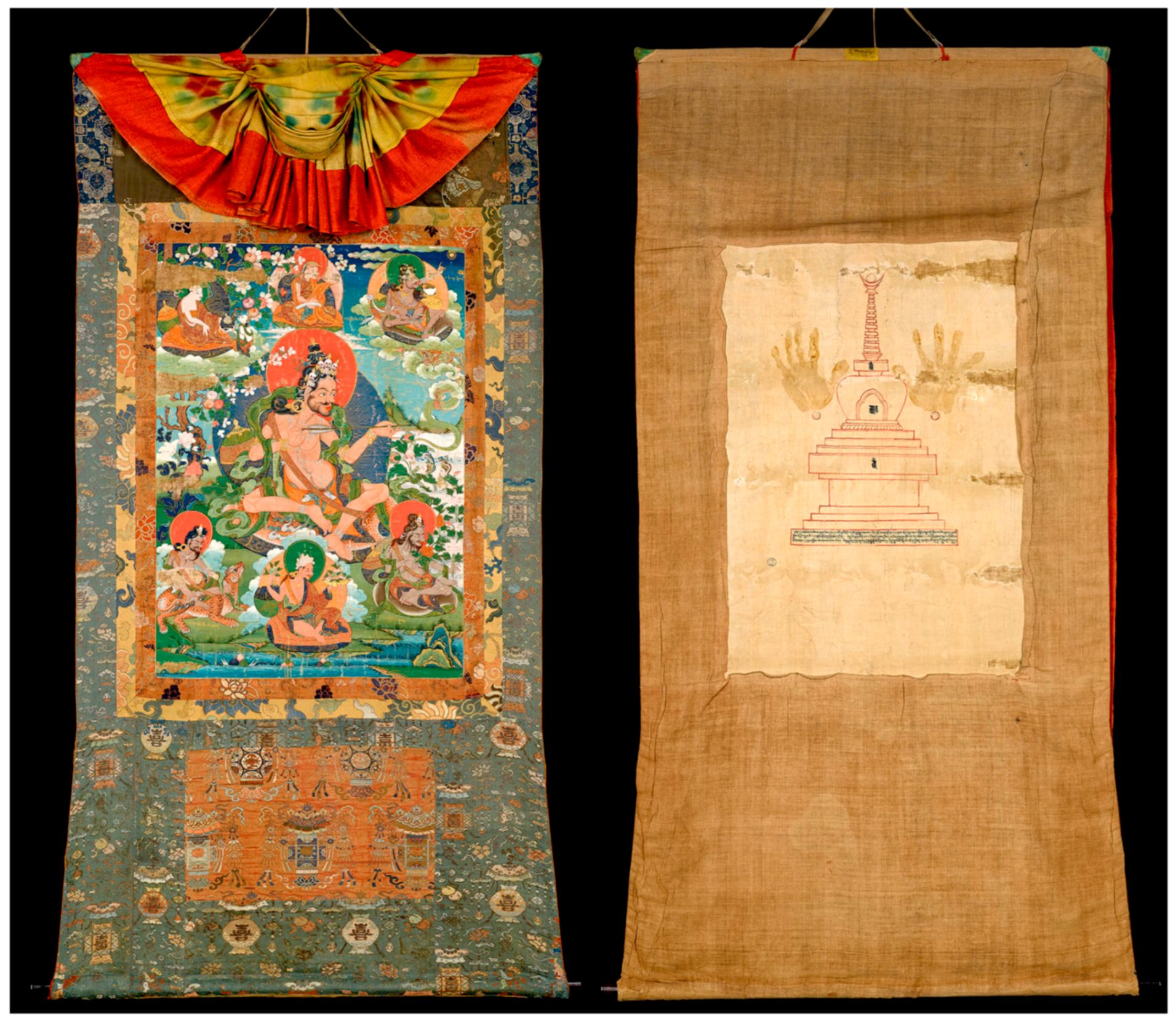
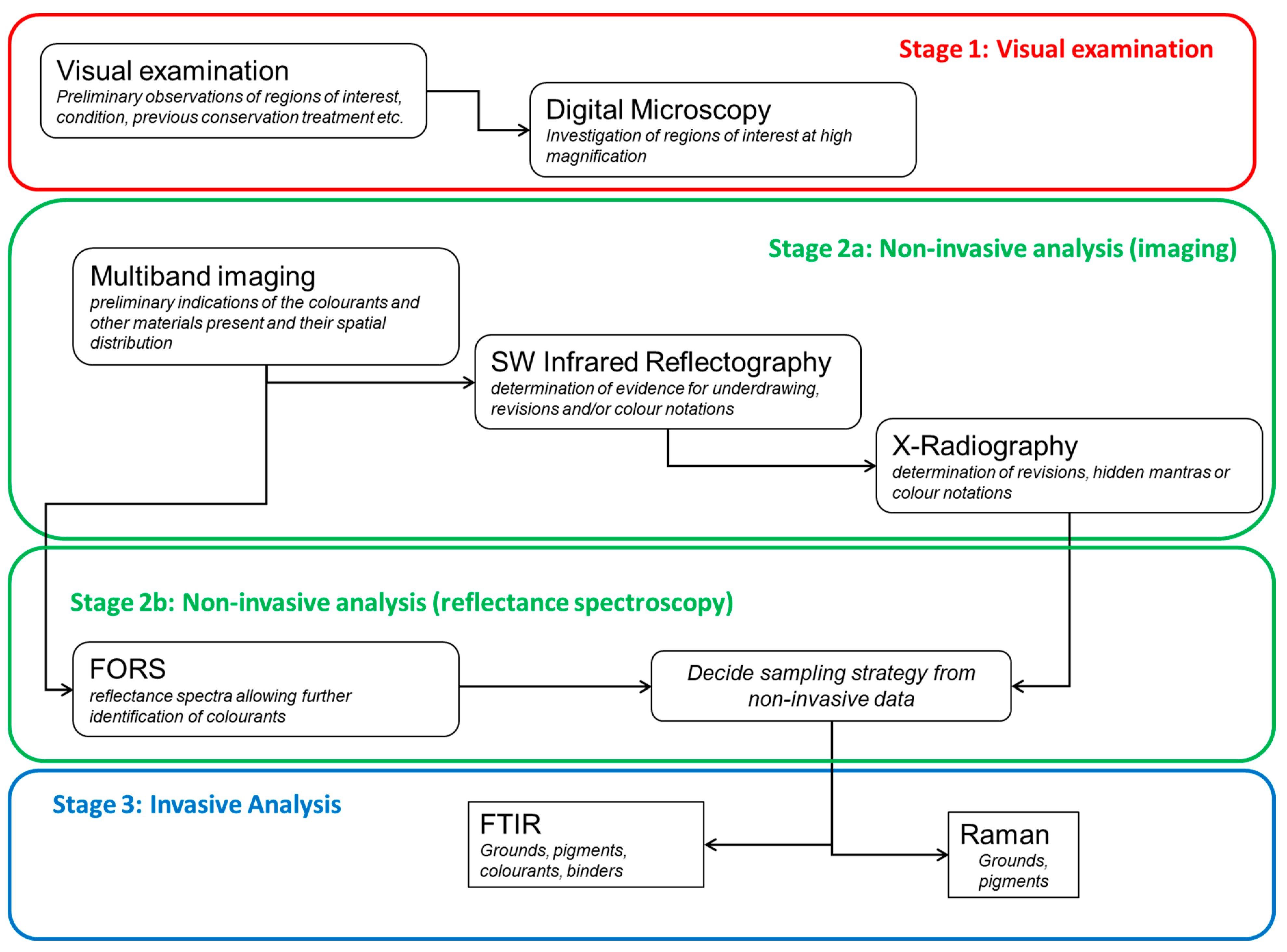
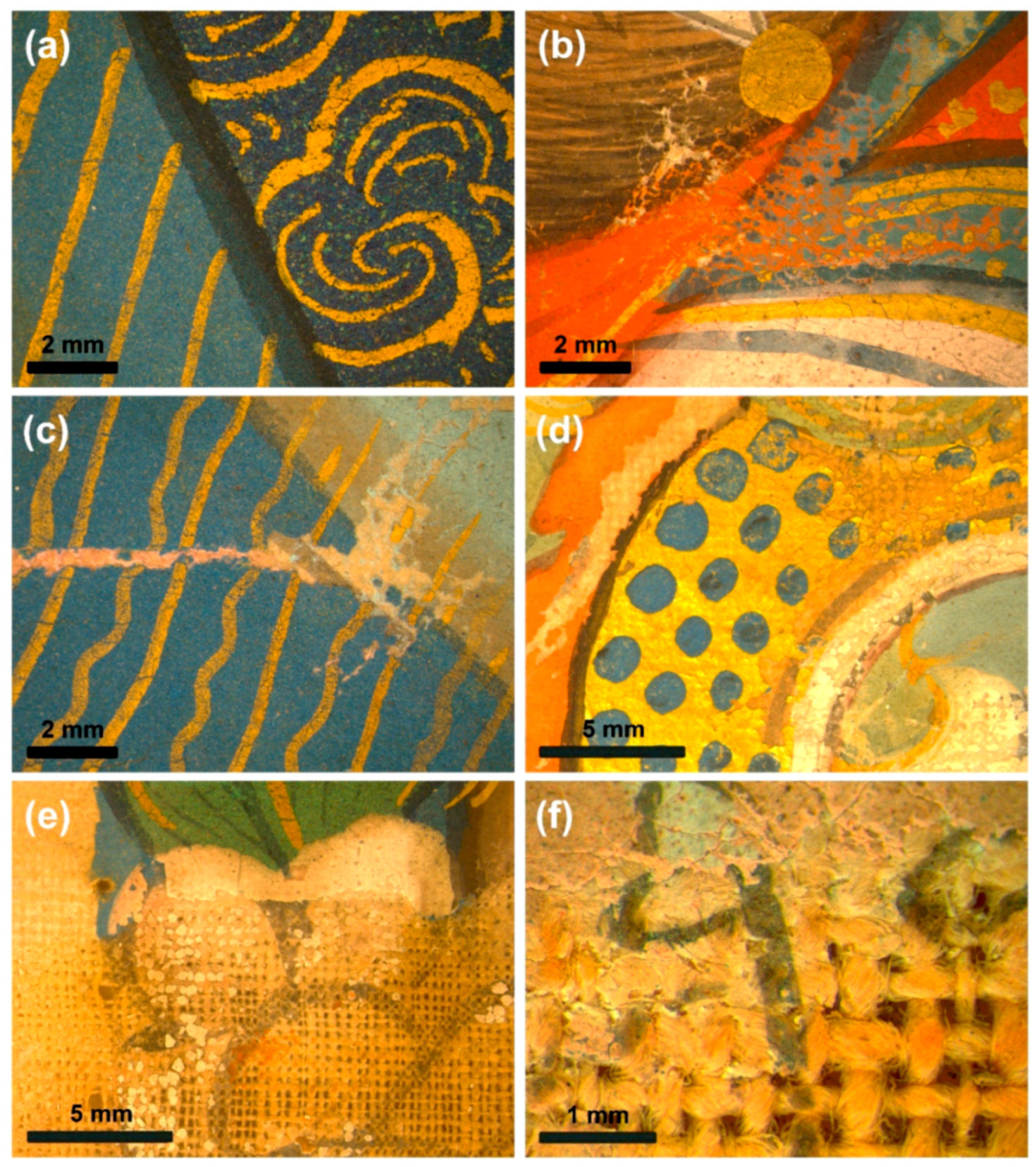
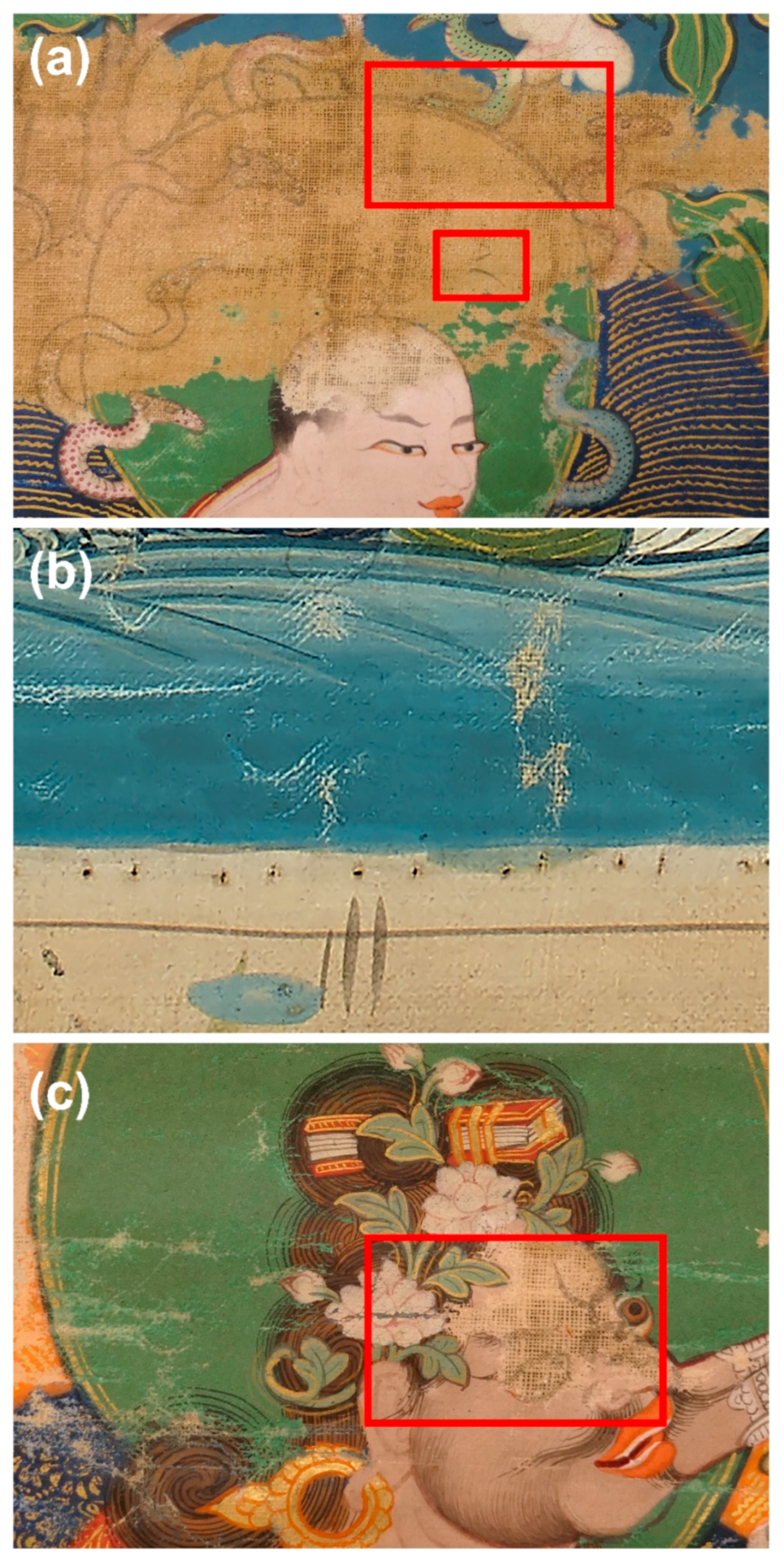

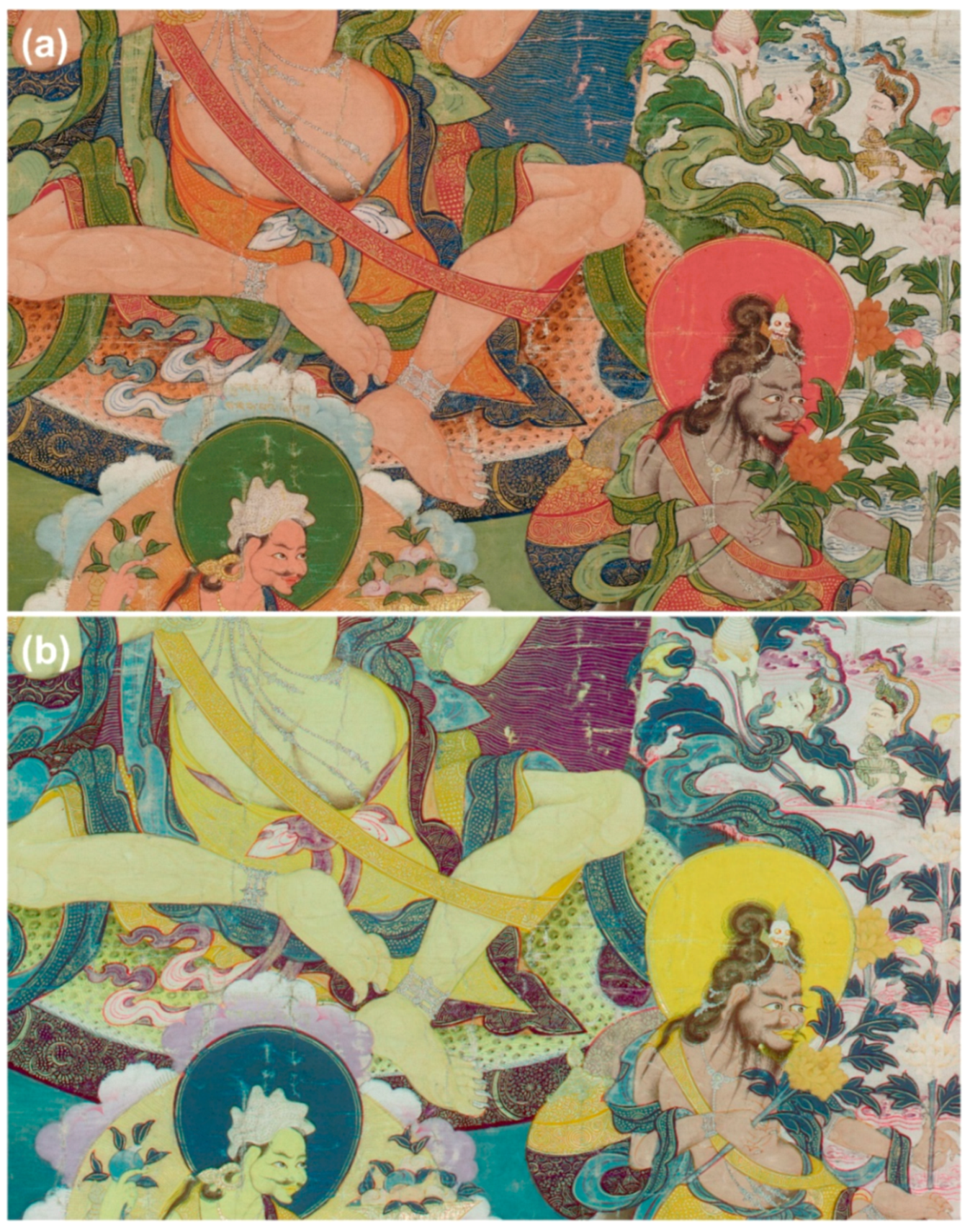
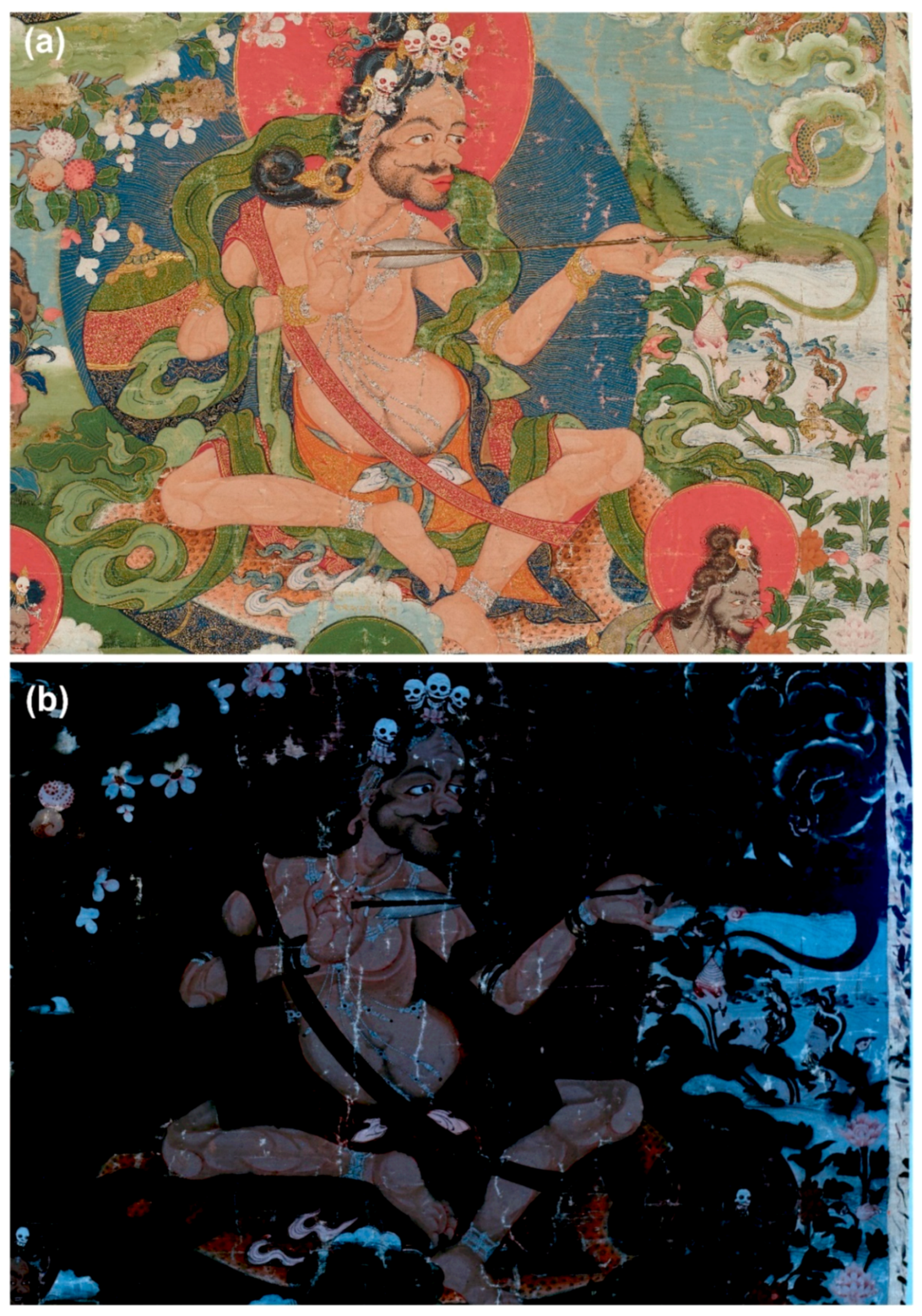
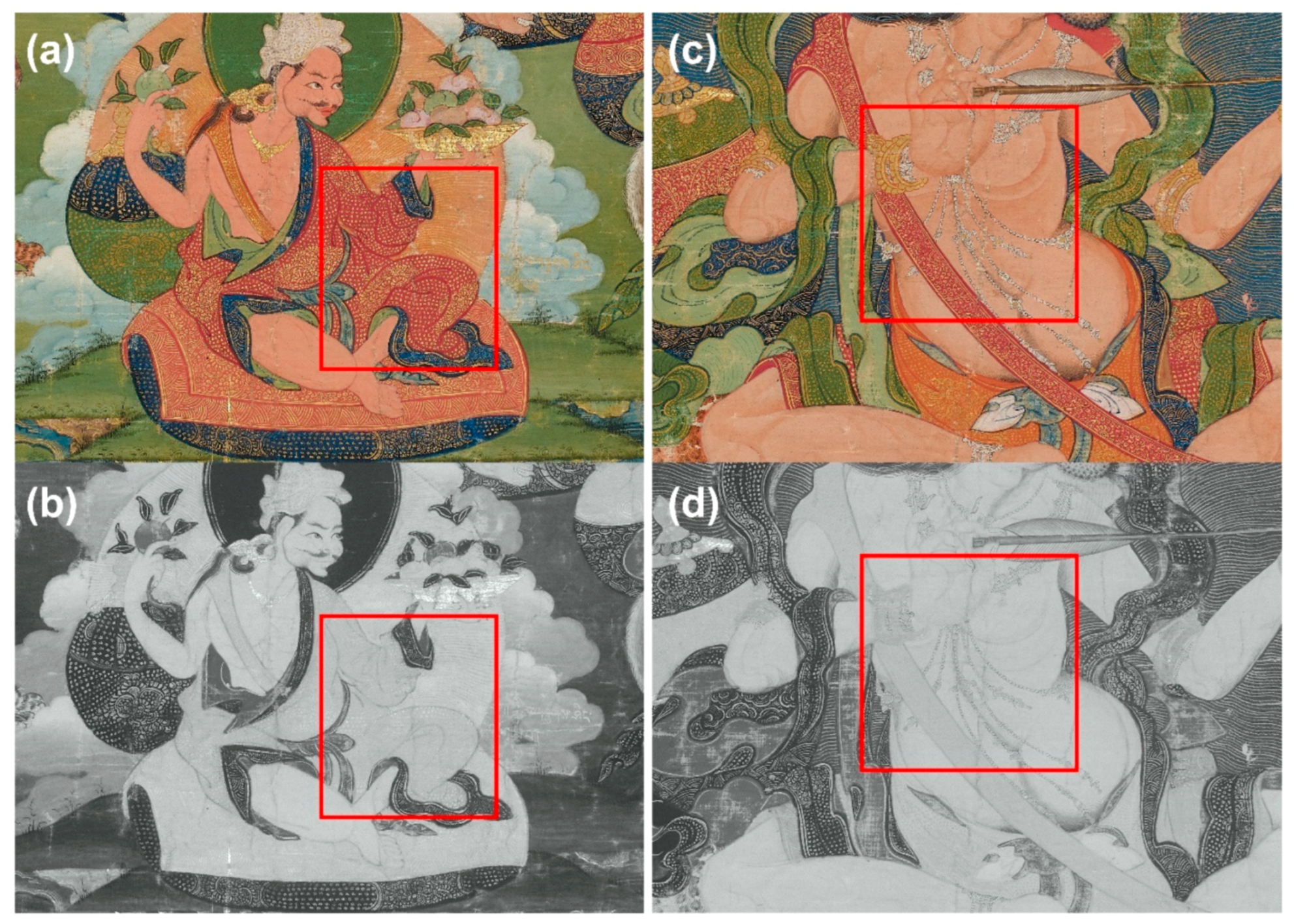

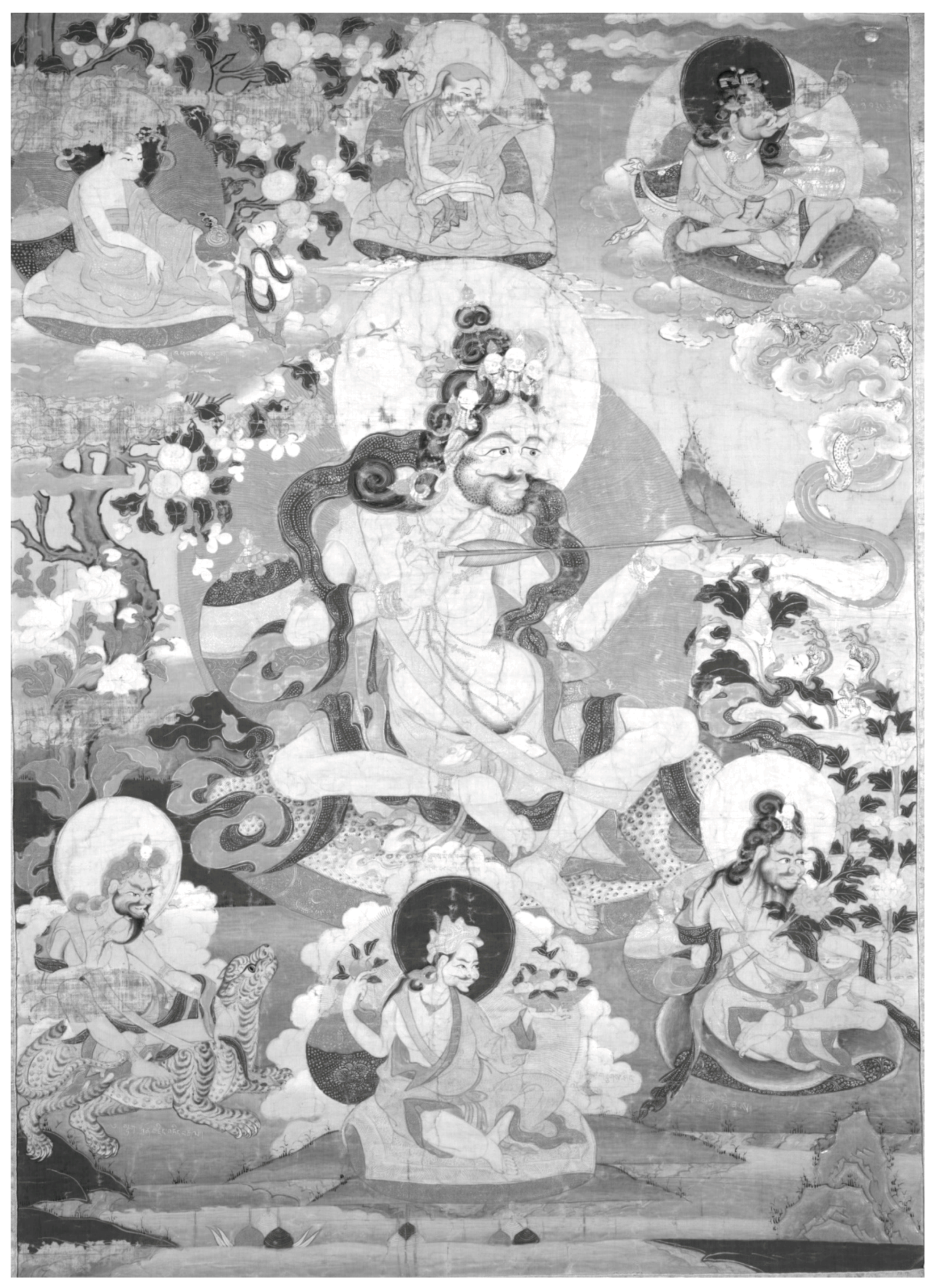

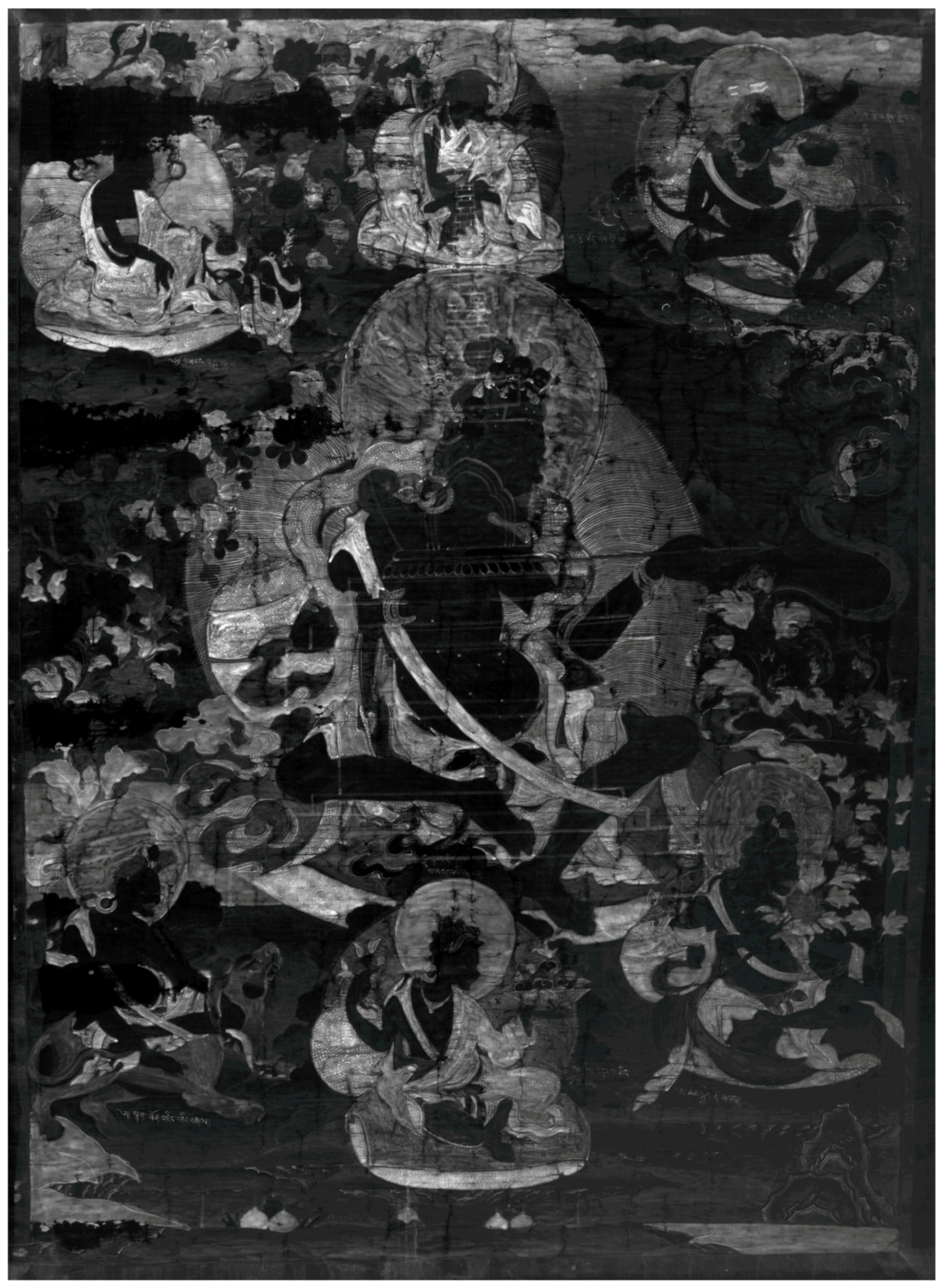
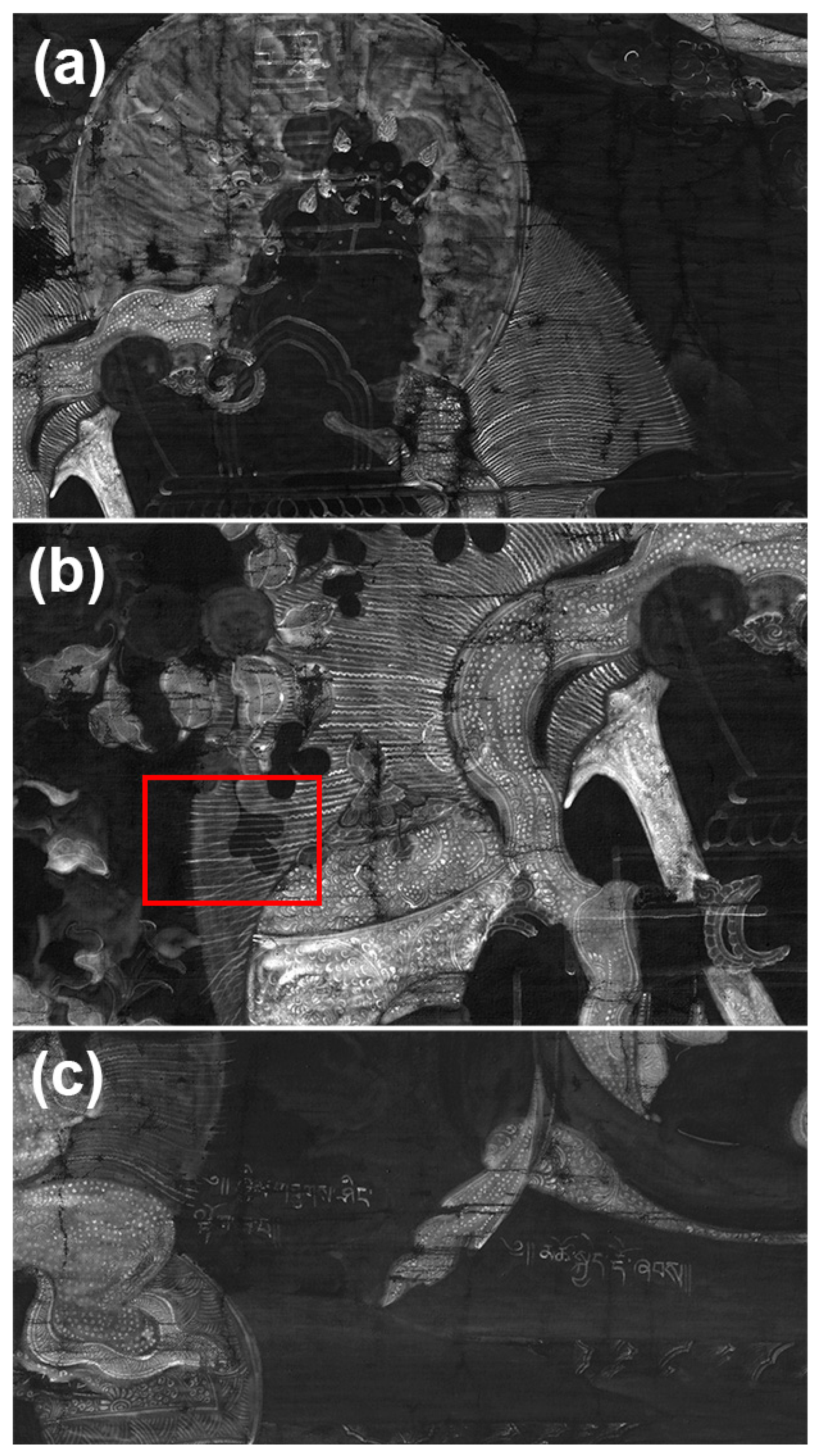
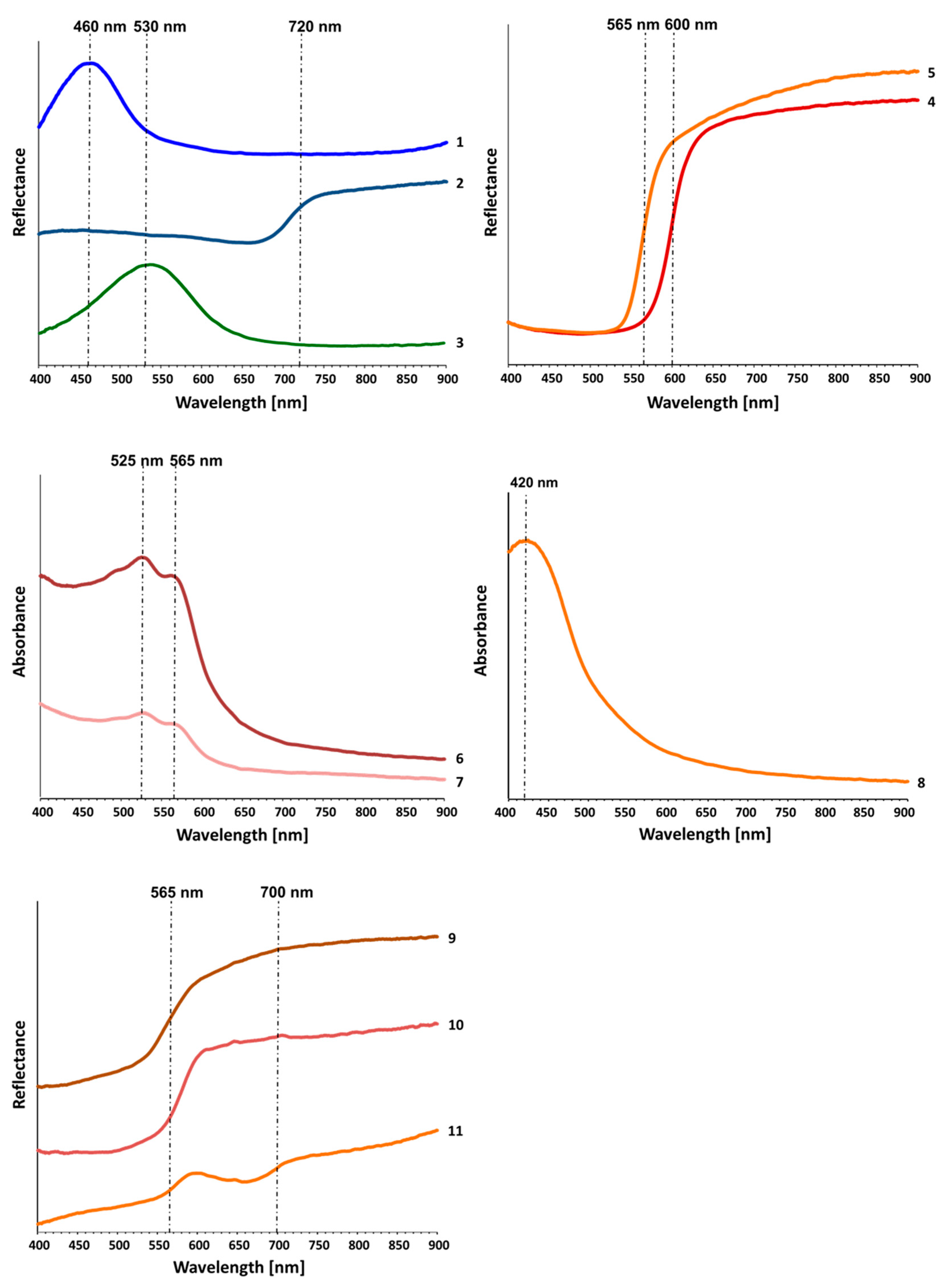
| MSI Technique | Radiation Sources | Filter(s) in Front of Camera | Range Investigated |
|---|---|---|---|
| Visible-reflected imaging (VIS) | Elinchrom 6000 Micro AS powerpack with A3000N flash heads, each equipped with Rotalux softboxes (diffuser) | No filter | ca. 380–700 nm |
| Ultraviolet-induced visible luminescence imaging (UVL) | Wood’s radiation sources (365 nm) filtered with a Schott DUG11 interference bandpass filter (280–400 nm) | Schott KV418 cut-on filter (50% transmission at c. 418 nm) | ca. 420–700 nm |
| Infrared-reflected imaging (IRR) | Elinchrom 6000 Micro AS powerpack with A3000N flash heads, each equipped with Rotalux softboxes (diffuser) | Kodak Wratten No. 87 filter (50% transmittance at c. 800 nm) | ca. 750–1100 nm |
| Broadband MSI | SWIR | X-ray | Conclusion at Stage 2a | Conclusion at Stage 2b (FORS) | Conclusion at Stage 3 (FTIR and Raman) | |||
|---|---|---|---|---|---|---|---|---|
| VIS | IRR | IRRFC | UVL | |||||
| Red | Transparent | Dark yellow | Dark (Absorbing) | Transparent | Bright | Mineral red, likely cinnabar/vermillion | Inflection point at 600 nm; Cinnabar/vermillion | - |
| Pink | Transparent | Dark yellow | Weak, deep red luminescence | Transparent | Dark | Organic red | Absorption bands at ca. 525 and 565 nm; insect-based red colourant, possibly Indian lac | - |
| Orange | Transparent | Yellow | Dark (Absorbing) | Transparent | Bright | Mineral red, likely minium/red lead | Inflection point at 565 nm; minium/red lead | - |
| Yellow | Transparent | Pale yellow | Yellow luminescence | Transparent | Dark | Organic yellow | Band at ca. 420 nm, with low reflectance in the near-infrared region; Organic yellow | - |
| Green | Opaque | Teal | Dark (Absorbing) | Opaque | Bright | Mineral green, likely malachite | Band at ca. 530 nm, with very low reflectance in the near-infrared region; malachite Slight shift in reflectance towards higher wavelengths (ca. 560 nm) in lighter green areas | FTIR bands at 3407, 3335, 1503, 1393, 1098, 1047, 882, 819 and 751 cm−1; malachite and 3583, 3575, 3489, 1157 and 989 cm−1; antlerite Raman bands at 971, 595, 480, 422, 384 and 196 cm−1; brochantite |
| Blue 1 | Opaque | Purple | Dark (Absorbing) | Some transparency | Bright | Mineral blue, likely azurite | Band at ca. 460 nm, with low reflectance in the near-infrared region; azurite | FTIR bands at 3704, 3621, 1118, 1034, 1003 and 914 cm−1; kaolinite and 3429, 1464, 1417, 956 and 840 cm−1; azurite Raman bands at 170, 247, 400, 542, 763, 836, 938, 1096, 1413, 1570 cm−1; azurite |
| Blue 2 | Transparent | Red | Weak, deep blue luminescence | Transparent | Dark | Organic blue, likely indigo | Inflection point at 720 nm; indigo | - |
| Brown | Partially opaque | Greyish-yellow? | Dark (Absorbing) | Some transparency | Dark | Mixture with yellow and carbon-based black (tentative) | - | - |
| Black | Opaque | Black | Dark (Absorbing) | Opaque | Dark | Carbon-based black | - | |
| Flesh tone 1—Peach | Transparent | Pale yellow | Weak luminescence | Transparent | Dark | Mixtures of a red/orange pigment with white (tentative) | Inflection point at 565 nm; minium/red lead, likely mixed with white | - |
| Flesh tone 2—Brown | Transparent | Pale orange | Weak luminescence | Transparent | Dark | Mixtures with white (tentative) | inflection points 575–590 nm and ca. 700 nm; iron-oxide-based pigment, likely mixed with white | - |
| White | Transparent | White | Bluish luminescence | Transparent | Dark | White pigment, not lead-based and likely based on calcium or magnesium. | - | FTIR bands at 1435, 888 and 747 cm−1; magnesite |
Publisher’s Note: MDPI stays neutral with regard to jurisdictional claims in published maps and institutional affiliations. |
© 2022 by the authors. Licensee MDPI, Basel, Switzerland. This article is an open access article distributed under the terms and conditions of the Creative Commons Attribution (CC BY) license (https://creativecommons.org/licenses/by/4.0/).
Share and Cite
Dyer, J.; Derham, A.; O’Flynn, D.; Tamburini, D.; Heady, T.; Ramos, I. Studying Saraha: Technical and Multi-Analytical Investigation of the Painting Materials and Techniques in an 18th Century Tibetan Thangka. Heritage 2022, 5, 2851-2880. https://doi.org/10.3390/heritage5040148
Dyer J, Derham A, O’Flynn D, Tamburini D, Heady T, Ramos I. Studying Saraha: Technical and Multi-Analytical Investigation of the Painting Materials and Techniques in an 18th Century Tibetan Thangka. Heritage. 2022; 5(4):2851-2880. https://doi.org/10.3390/heritage5040148
Chicago/Turabian StyleDyer, Joanne, Alice Derham, Daniel O’Flynn, Diego Tamburini, Teresa Heady, and Imma Ramos. 2022. "Studying Saraha: Technical and Multi-Analytical Investigation of the Painting Materials and Techniques in an 18th Century Tibetan Thangka" Heritage 5, no. 4: 2851-2880. https://doi.org/10.3390/heritage5040148
APA StyleDyer, J., Derham, A., O’Flynn, D., Tamburini, D., Heady, T., & Ramos, I. (2022). Studying Saraha: Technical and Multi-Analytical Investigation of the Painting Materials and Techniques in an 18th Century Tibetan Thangka. Heritage, 5(4), 2851-2880. https://doi.org/10.3390/heritage5040148







